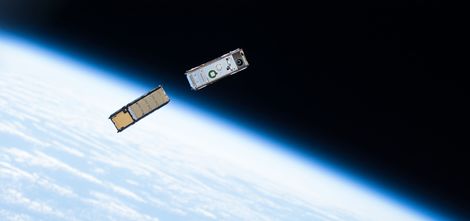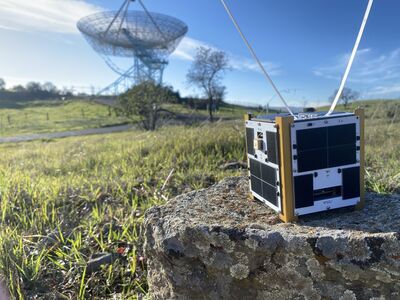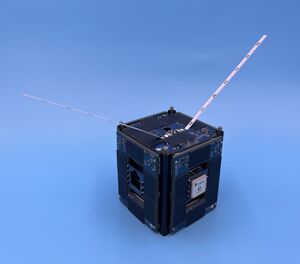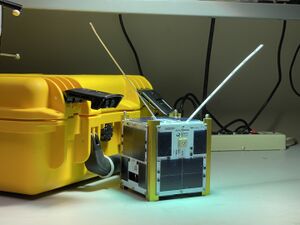Difference between revisions of "Category:Satellites"
(→Sapling Giganteum: 2022–2023: Continued to update Sapling-2 description) |
(→Sapling Giganteum: 2022–2023: Added detail to Sapling-2, added section on "what is a cubesat?") |
||
| Line 18: | Line 18: | ||
== Our Website: [https://saplingsat.org saplingsat.org] == | == Our Website: [https://saplingsat.org saplingsat.org] == | ||
| − | One of our main goals of the satellites team is to increase accessibility to space, and while we can have made a ton of progress on this from an engineering standpoint, it's pretty limited unless we get the word out. So we made a website! At [https://saplingsat.org saplingsat.org], you'll be able to find everything from our project overview to how to assemble our main flight computer. If you wanna take a deep dive into our software repositories or just brush up on terminology, the website is the place for you :) | + | One of our main goals of the satellites team is to increase accessibility to space, and while we can have made a ton of progress on this from an engineering standpoint, it's pretty limited unless we get the word out. So we made a website! At [https://saplingsat.org '''saplingsat.org'''], you'll be able to find everything from our project overview to how to assemble our main flight computer. If you wanna take a deep dive into our software repositories or just brush up on terminology, the website is the place for you :) |
== Current Mission: SAMWISE == | == Current Mission: SAMWISE == | ||
Our current mission is SAMWISE, a 2U CubeSat (10cm x 10cm x 20cm rectangle) with a bunch of super cool technologies. Stay tuned. | Our current mission is SAMWISE, a 2U CubeSat (10cm x 10cm x 20cm rectangle) with a bunch of super cool technologies. Stay tuned. | ||
| + | |||
| + | == What is a CubeSat? == | ||
| + | A [https://en.wikipedia.org/wiki/CubeSat CubeSat] is a small satellite that fits a particular size requirement. These specifications, created by professors at Stanford and Cal Poly, help to make launching satellites far more accessible because they help to lower costs. Since any CubeSat can fit into any standardized deployer, launch providers and third-party companies spend a lot less money getting the satellites to fit onto the rocket! | ||
| + | |||
| + | CubeSats come in standardized "units," abbreviated with a "U." A 1U CubeSat is the smallest size, with dimensions of around 10cm by 10cm by 10cm. A larger 2U is just like two 1U's stacked on top of each other, so instead of 10cm tall it's 20cm. A 3U is the same thing again, 30cm tall. Bigger CubeSats like a 6U (30cm x 20cm x 10cm) exist as well, and as size increases so does cost. Our first satellites were 1U satellites, but we're starting to build bigger ones! | ||
== Subteams == | == Subteams == | ||
| Line 41: | Line 46: | ||
Welcome to the payload subteam! The payload often defines the mission of the satellite, so it's basically the most important part :) These payloads can be anything from telescopes like Hubble to communication systems like Starlink. Our recent satellites have largely focused on low-cost camera systems and radio modules. This subteam covers a huge variety of topics, so no matter your interests definitely join the Slack and reach out! | Welcome to the payload subteam! The payload often defines the mission of the satellite, so it's basically the most important part :) These payloads can be anything from telescopes like Hubble to communication systems like Starlink. Our recent satellites have largely focused on low-cost camera systems and radio modules. This subteam covers a huge variety of topics, so no matter your interests definitely join the Slack and reach out! | ||
| − | Our current projects are developing a multi-camera system and a higher speed radio module for the SAMWISE mission. This system is based on the Raspberry Pi architecture and will include an Earth-facing camera, a star tracker used in conjunction with our ADCS system, and a selfie camera! The higher speed radio will allow us to more quickly send images back | + | Our current projects are developing a multi-camera system and a higher speed radio module for the SAMWISE mission. This system is based on the Raspberry Pi architecture and will include an Earth-facing camera, a star tracker used in conjunction with our ADCS system, and a selfie camera! The higher speed radio will allow us to more quickly send images back down to Earth. |
| − | |||
| − | |||
=== Software === | === Software === | ||
| Line 52: | Line 55: | ||
Slack channel: [https://ssi-teams.slack.com/messages/satellites-structures satellites-structures] Subteam Leads: Jacob Mukobi, Siolé Mayeski, and Jeremy Merritt | Slack channel: [https://ssi-teams.slack.com/messages/satellites-structures satellites-structures] Subteam Leads: Jacob Mukobi, Siolé Mayeski, and Jeremy Merritt | ||
| − | + | Hi! This is the structures subteam, where we design and build the core mechanical components of the satellite. The structure holds everything together and allows for the satellite to fit into CubeSat standard deployers, which push the satellite out of the spacecraft in orbit. If you're interested in mechanical engineering this is definitely the subteam for you, but of course everyone is welcome! | |
| + | |||
| + | Our upcoming satellite is going to be twice as big as our last one, so one of the big projects this year is to design its structure! It will be an evolution of our current sheet metal structure and its design will determine how everything else in the satellite fits together. We're also going to be including a number of deployables (stuff that folds out from the main structure) on this upcoming satellite, including bigger solar panels and a selfie stick (!!!), so if you're interested at all click that link above and join the Slack channel! | ||
=== Systems === | === Systems === | ||
| Line 70: | Line 75: | ||
Sapling-2 also showcased an advanced attitude determination and control system (ADCS) featuring magnetorquer coils positioned on each of the six faces of the satellite. When activated, the magnetic field created by these coils interacts with the Earth's magnetic field and generates a torque on the satellite, allowing for rotation around all three axes. This could be used to de-tumble the satellite after deployment and for pointing of the Google Coral camera. | Sapling-2 also showcased an advanced attitude determination and control system (ADCS) featuring magnetorquer coils positioned on each of the six faces of the satellite. When activated, the magnetic field created by these coils interacts with the Earth's magnetic field and generates a torque on the satellite, allowing for rotation around all three axes. This could be used to de-tumble the satellite after deployment and for pointing of the Google Coral camera. | ||
| − | On June 18th, 2023, Sapling-2 stopped sending telemetry. While the precise cause is unknown, it is likely that a solar storm which occurred around that time disabled the satellite. Prior to its shutdown the satellite was in good health, with a high state of charge and in a nominal temperature range. | + | On June 18th, 2023, Sapling-2 stopped sending telemetry. While the precise cause is unknown, it is likely that a solar storm which occurred around that time disabled the satellite. Prior to its shutdown the satellite was in good health, with a high state of charge and in a nominal temperature range. Despite this early loss of the satellite, Sapling-2 was a success on a great number of levels and laid the groundwork for future missions. |
=== ''Sapling'' ''Sempervirens'': 2020–2023 === | === ''Sapling'' ''Sempervirens'': 2020–2023 === | ||
[[File:Sapling1.jpeg|thumb|''Sapling Sempervirens'' before delivery]] | [[File:Sapling1.jpeg|thumb|''Sapling Sempervirens'' before delivery]] | ||
| − | Also referred to as Sapling-1, this was the first of the ''Sapling'' 1U | + | Also referred to as Sapling-1, this was the first of the ''Sapling'' 1U CubeSats. While [https://ssi-wiki.stanford.edu/Category:Satellites#POINTR:_.5Byear.5D.E2.80.932018 POINTR] was the Satellite team's first payload to reach space, Sapling-1 would be the first entire satellite designed and built in-house by SSI. |
| + | |||
| + | Paragraph on the avionics (PyCubed version, battery board) | ||
| + | |||
| + | Paragraph on the software? | ||
| + | |||
| + | The payload of Sapling-1 consisted of a [https://coral.ai/products/dev-board-mini Google Coral Dev Board Mini] computer and a [https://coral.ai/products/camera/ Google Coral Camera]. This payload was selected to demonstrate on-orbit image processing and selection using an AI filter. The Coral would use this processing to select a single "best" image out of a series of images taken, reducing the amount of data needed to be transmitted down to Earth. The camera was mounted on the Z- face of the satellite opposite the antennas (towards the table in the photo on the right). | ||
=== Sequoia: 2019–2020 === | === Sequoia: 2019–2020 === | ||
| − | Sequoia was a planned 3U CubeSat that would demonstrate on-board image classification and processing with updateable machine learning models. The goal of the project was to obtain a high volume of scientifically important imagery for ecological and climatology research. Researchers many times have no need of images saturated with clouds or uninteresting areas—so why not filter them out with a convolutional neural network? | + | Sequoia was a planned 3U CubeSat that would demonstrate on-board image classification and processing with updateable machine learning models. The goal of the project was to obtain a high volume of scientifically important imagery for ecological and climatology research. Researchers many times have no need of images saturated with clouds or uninteresting areas—so why not filter them out with a convolutional neural network? Sequoia’s deep learning with images taken by the satellite would be retained, with improvements implemented on-orbit. SSI worked on developing deep learning models for forest fire risk assessment and detection and a number of other applications. The mission architecture was user definable with the operator specifying desirable image locations or types and resolutions, and the satellite planned to maximize delivery of fully open-source images. |
Project materials can be found in the [https://github.com/stanford-ssi/Sequoia Sequoia GitHub]. | Project materials can be found in the [https://github.com/stanford-ssi/Sequoia Sequoia GitHub]. | ||
=== POINTR: [year]–2018 === | === POINTR: [year]–2018 === | ||
| − | The Satellites | + | The Satellites team developed various [[Optical Communications]] technologies, culminating in the launch of [[POINTR]]. This was a 1U segment of a 3U CubeSat launched in 2018, but it unfortunately never connected with ground control due to improper orbital insertion from the launch provider. |
=== Additional Projects === | === Additional Projects === | ||
Revision as of 02:41, 15 September 2023
Welcome to the SSI Satellites Team! Whether you're an incoming frosh, tired old senior, graduate student, alumni, or even not a part of the Stanford community, we're glad you're here. Our current mission is SAMWISE, a CubeSat with a number of technological advancements compared to our prior missions. Our Satellite Team Leads are
Getting Started with Satellites
Stanford Affiliated 🌲
If you're a Stanford student, professor, or affiliate we'd love for you to join the Satellites community! For information on joining SSI as a whole, check out the How to Join SSI page.
Once you've joined our Slack messaging hub, you'll be able to join all of our Satellites-specific channels! Definitely join the general satellites channel which is where we'll post all of our major updates and make big announcements. We've also got a lot of subteams, each with their own channel (we love our Slack channels here at SSI). Check out the Subteams section on this page to learn about them and join any channels you find interesting.
And of course if any questions or confusions come up, don't hesitate to reach out to any of the Satellite Team Leads. Also feel free to reach out to Subteam Leads if you have subteam-specific questions!
Outside Stanford ❄️
If you're not affiliated with Stanford but are interested in the team and our projects, we'd still love to have you! To get in touch, please email one or all of the team leads Ashley Raigosa, Spencer Wallace, and Theo Makler.
Onboarding Events Calendar
Check out the SSI Updated General Event Calendar to stay up-to-date on all of our onboarding events! This is still a work-in-progress so stay tuned for more information :)
Our Website: saplingsat.org
One of our main goals of the satellites team is to increase accessibility to space, and while we can have made a ton of progress on this from an engineering standpoint, it's pretty limited unless we get the word out. So we made a website! At saplingsat.org, you'll be able to find everything from our project overview to how to assemble our main flight computer. If you wanna take a deep dive into our software repositories or just brush up on terminology, the website is the place for you :)
Current Mission: SAMWISE
Our current mission is SAMWISE, a 2U CubeSat (10cm x 10cm x 20cm rectangle) with a bunch of super cool technologies. Stay tuned.
What is a CubeSat?
A CubeSat is a small satellite that fits a particular size requirement. These specifications, created by professors at Stanford and Cal Poly, help to make launching satellites far more accessible because they help to lower costs. Since any CubeSat can fit into any standardized deployer, launch providers and third-party companies spend a lot less money getting the satellites to fit onto the rocket!
CubeSats come in standardized "units," abbreviated with a "U." A 1U CubeSat is the smallest size, with dimensions of around 10cm by 10cm by 10cm. A larger 2U is just like two 1U's stacked on top of each other, so instead of 10cm tall it's 20cm. A 3U is the same thing again, 30cm tall. Bigger CubeSats like a 6U (30cm x 20cm x 10cm) exist as well, and as size increases so does cost. Our first satellites were 1U satellites, but we're starting to build bigger ones!
Subteams
Building a satellite is definitely not a simple task! There's a lot that goes into each one, so to help streamline things we divide up into subteams. Each of these subteams has a specific task associated with the satellite, and together they work together to make the mission a success! Below you'll find descriptions of each subteam, ways to contact our current subteam leads, and links to their respective Slack channels.
Attitude Determination and Control (ADCS)
Slack Channel: satellites-adcs Subteam Lead: Grant Regen
Here's the description
Avionics
Slack channel: satellites-avionics Subteam Lead: Hunter Liu
Here's the description
Payload
Slack channel: satellites-payload Subteam Lead: Niklas Vainio
Welcome to the payload subteam! The payload often defines the mission of the satellite, so it's basically the most important part :) These payloads can be anything from telescopes like Hubble to communication systems like Starlink. Our recent satellites have largely focused on low-cost camera systems and radio modules. This subteam covers a huge variety of topics, so no matter your interests definitely join the Slack and reach out!
Our current projects are developing a multi-camera system and a higher speed radio module for the SAMWISE mission. This system is based on the Raspberry Pi architecture and will include an Earth-facing camera, a star tracker used in conjunction with our ADCS system, and a selfie camera! The higher speed radio will allow us to more quickly send images back down to Earth.
Software
Slack channel: satellites-software Subteam Lead: Kien Deshpande
Here's the description
Structures
Slack channel: satellites-structures Subteam Leads: Jacob Mukobi, Siolé Mayeski, and Jeremy Merritt
Hi! This is the structures subteam, where we design and build the core mechanical components of the satellite. The structure holds everything together and allows for the satellite to fit into CubeSat standard deployers, which push the satellite out of the spacecraft in orbit. If you're interested in mechanical engineering this is definitely the subteam for you, but of course everyone is welcome!
Our upcoming satellite is going to be twice as big as our last one, so one of the big projects this year is to design its structure! It will be an evolution of our current sheet metal structure and its design will determine how everything else in the satellite fits together. We're also going to be including a number of deployables (stuff that folds out from the main structure) on this upcoming satellite, including bigger solar panels and a selfie stick (!!!), so if you're interested at all click that link above and join the Slack channel!
Systems
Slack channel: satellites-systems Subteam Lead: kinda everyone!
Here's the description
Past Missions
Sapling Giganteum: 2022–2023
Also referred to as Sapling-2, this was the second of the Sapling series of 1U CubeSats. This mission represented a major step forward in our satellite design and became the first SSI satellite to successfully make contact with the ground once deployed.
Sapling-2 launched on SpaceX's Transporter 7 at 11:48pm on April 14th, 2023 from Vandenburg Space Force Base in Southern California. Shortly after deployment contact was made with SSI's Durand ground station.
In addition to incremental but critical improvements to the internal electronics of the satellite, Sapling-2 featured a number of major changes from the design of Sapling-1. The first iteration of the (name for the sheet metal structure) debuted on this satellite. This structure, made of off-the-shelf aluminum cut with a CNC and bent into precise shape before being anodized, lowered material costs and allowed for rapid prototyping. An evolution of this structure is being created for the SAMWISE satellite and will underpin all missions in the near future.
Sapling-2 also showcased an advanced attitude determination and control system (ADCS) featuring magnetorquer coils positioned on each of the six faces of the satellite. When activated, the magnetic field created by these coils interacts with the Earth's magnetic field and generates a torque on the satellite, allowing for rotation around all three axes. This could be used to de-tumble the satellite after deployment and for pointing of the Google Coral camera.
On June 18th, 2023, Sapling-2 stopped sending telemetry. While the precise cause is unknown, it is likely that a solar storm which occurred around that time disabled the satellite. Prior to its shutdown the satellite was in good health, with a high state of charge and in a nominal temperature range. Despite this early loss of the satellite, Sapling-2 was a success on a great number of levels and laid the groundwork for future missions.
Sapling Sempervirens: 2020–2023
Also referred to as Sapling-1, this was the first of the Sapling 1U CubeSats. While POINTR was the Satellite team's first payload to reach space, Sapling-1 would be the first entire satellite designed and built in-house by SSI.
Paragraph on the avionics (PyCubed version, battery board)
Paragraph on the software?
The payload of Sapling-1 consisted of a Google Coral Dev Board Mini computer and a Google Coral Camera. This payload was selected to demonstrate on-orbit image processing and selection using an AI filter. The Coral would use this processing to select a single "best" image out of a series of images taken, reducing the amount of data needed to be transmitted down to Earth. The camera was mounted on the Z- face of the satellite opposite the antennas (towards the table in the photo on the right).
Sequoia: 2019–2020
Sequoia was a planned 3U CubeSat that would demonstrate on-board image classification and processing with updateable machine learning models. The goal of the project was to obtain a high volume of scientifically important imagery for ecological and climatology research. Researchers many times have no need of images saturated with clouds or uninteresting areas—so why not filter them out with a convolutional neural network? Sequoia’s deep learning with images taken by the satellite would be retained, with improvements implemented on-orbit. SSI worked on developing deep learning models for forest fire risk assessment and detection and a number of other applications. The mission architecture was user definable with the operator specifying desirable image locations or types and resolutions, and the satellite planned to maximize delivery of fully open-source images.
Project materials can be found in the Sequoia GitHub.
POINTR: [year]–2018
The Satellites team developed various Optical Communications technologies, culminating in the launch of POINTR. This was a 1U segment of a 3U CubeSat launched in 2018, but it unfortunately never connected with ground control due to improper orbital insertion from the launch provider.
Additional Projects
In addition to projects taken on by the team as a whole, satellites members have worked in Stanford faculty labs to build:
- SNAPS, the Stanford NAno Picture Satellite, a 1/4U imaging CubeSat deployed from the ISS in 2016
- QB50 Discovery, Stanford's submission to an international 50-member CubeSat constellation
- Morgana, a CubeSat designed to study high energy particles in the upper atmosphere. (Cancelled)
Photos
If you've got a Stanford login you can take a look at our photos! The satellites photos can be found here.
Old Documentation
This team has been around for a long time! There's a lot of sub-pages on this wiki that are now redundant because of our website or are simply outdated. Until I figure out what to do with them I'll keep all the links in this section so we don't loose anything – Theo :)
Pages in category "Satellites"
The following 21 pages are in this category, out of 21 total.



